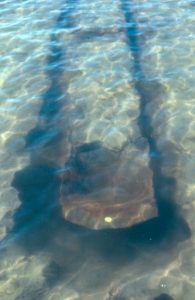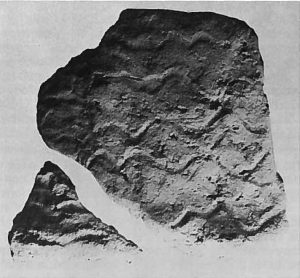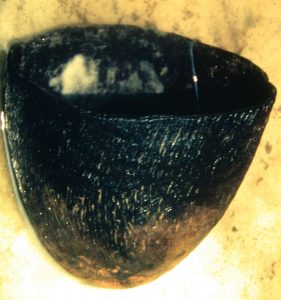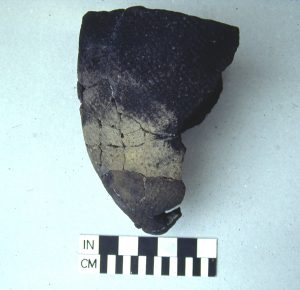Lake Phelps
Ancient Pots and Dugout Canoes:
Indian Life as Revealed by Archaeology at Lake Phelps
Lake Phelps Reveals Its Secrets
Each year in September, Pettigrew State Park celebrates Indian Heritage Week with a series of displays and demonstrations of Native American artifacts and customs in honor of the original inhabitants of our state. This celebration at the Park is possible because of the recovery of a remarkable set of Indian artifacts from Lake Phelps.

In the summer of 1984, an extensive forest fire in the vicinity of Lake Phelps was fought with water pumped from the lake, resulting in a lowered water level much below what had been the normal level for some time. Dry weather during the remainder of that year and in succeeding years has kept the lake level below normal until quite recently. In the fall of 1984, fishermen began to report artifacts that were now readily observable on the lake bottom through the shallow, crystal clear water. A number of these, including partial and whole clay pots and stone objects, were collected and deposited at Pettigrew State Park. During the next year artifact collection continued and in November 1985, the first of a number of dugout canoes was discovered by Park personnel. It was that discovery, along with the unusually well preserved artifacts, that focused attention on the archaeological potential of Lake Phelps and initiated a cooperative research project with the goal of understanding the secrets of Lake Phelps’ past cultures. The on-going research program is a joint effort by the North Carolina Division of Parks and Recreation, East Carolina University, The North Carolina Division of Archives and History and the North Carolina Maritime Museum.
As of the writing of this pamphlet, hundreds of artifacts spanning 11,000 years have been collected and 30 dugout canoes have been reported, qualifying them as the largest number of canoes in the southeastern United States still in association with the sites where they were manufactured and used. The Lake Phelps material has significantly increased not only our knowledge of ancient canoes but also our understanding of how people in the past used the lake and its surrounding environment. This pamphlet provides a summary of the information presently available from the research.
The Lake and Its Archaeological Sites
Lake Phelps is located in Pettigrew State Park in Washington and the very western fringe of Tyrrell counties, North Carolina (see map on back cover). It is a shallow, 16,600-acre lake, the second largest in the state, characteristic of a group of oval-shaped lakes and pocosins known as “Carolina Bays” distributed along the Middle Atlantic and Southeastern coastal plain. Past explanations for the origin of these natural features have ranged from meteorite showers to peat burns, but current geological research suggests that Lake Phelps may have formed in response to processes of coastal plain land form development sometime within the last 12,000 years. The lake, like others of its type, was a land-locked internal drainage basin until the last decades of the 18th century when plantations were established there and canals were cut from the lake to the Scuppernong River and to drain the adjacent peat bogs in order to farm them. Prior to the canals, the lake level would have fluctuated in response to rainfall and temperature.

Beginning about 11,000 years ago, people came to the lake to take advantage of the food resources available there. They camped along the low ridges on the northern and western shores, made and used the dugout canoes, and generally followed their daily routines, generation after generation. As the generations passed, the artifacts they broke, lost, or threw away accumulated in their living areas as evidence of their presence. Through time, also, the lake rose and fell, alternately eroding the shoreline and resorting the sediments. As the lake eroded the living sites, the artifacts lying there and the canoes abandoned along old shorelines were covered with sediments deposited by the higher water level. When the lake fell, the gentle wave action removed the sediments from the canoes and artifacts, exposing them as it did in 1984. No doubt this cycle has repeated itself numerous times in the past, but no one noticed (or recorded it) until the present situation.

Most remarkable among the artifacts from Lake Phelps are the ancient canoes. To date, 30 have been reported but only 23 of these have been measured and studied. The canoes are scattered along the northern and western shores of the lake adjacent to the archaeological sites where they were made, used and eventually abandoned. A detailed study of the shape, size and manufacturing techniques of the canoes is still in progress, but all appear to have been made by first splitting a cypress log, then alternately burning and scraping the interior of the canoe until the desired shape and size was obtained. In this manner, two canoes could be made from each log. Some of the canoes are nothing more than fragments while other are essentially intact, preserved by the acidic water and long burial in the lake bottom sediments. There appear to be a number of end (bow and stem) shape variations and the length of the longest canoe found so far is 37 feet. Three of the canoes have been preserved and are on display at Pettigrew State Park. Nineteen of the canoes have been dated by the radiocarbon process, and they range in age from 2430 B.C. to A.D. 1400, correlating closely with the known age of the other artifacts from the lake.

The Lake Phelps Culture Sequence
The canoes and other artifacts from Lake Phelps represent a sequence of occupations at the lake which correlate with the general culture history of northeastern North Carolina. That sequence is shown on the accompanying chart and what is known of the artifacts and lifeways of each phase in the sequence is described below.
The Earliest Inhabitants
The evidence of earliest human presence at the lake consists of two small spear points of the Palmer type generally dated to the Late Paleoindian period (8000-9000 B.C.) These artifacts may relate to small hunting and gathering camps near the newly formed lake during a time of colder climate, coniferous forests and fewer food resources.
The Early (8000-5000 B.C.) and Middle (5000-3000 B.C.) Archaic period is equally poorly represented in the Lake Phelps collections by a Kirk and a Morrow Mountain spear point, respectively. These, like the Paleo-Indian points before them, may remain from temporary camps or hunting expeditions passing along the shore. During the Archaic period the climate began to warm, resources became more abundant and in the later years of the period more frequent use of the lake began.
The Late Archaic

In the Late Archaic period (3000-1000 B.C.) the climate of the region had reached approximately modem conditions which supported forest types much like those of today, with cypress along the lake shore, mixed deciduous forest on the ridge above the shore and typical peat bog growth beyond and away from the lake. Fish, game and edible plant resources were more abundant and the archaeological evidence indicates a more frequent use of the lake area. Hunting activity is represented by spear points, a spear thrower weight and bifacial blades; cooking vessels made of soapstone suggest longer stays at the lake, perhaps for a season of food gathering activities. The three earliest dugout canoes belong to this period, the oldest dating to around 2430 B.C.; their presence also argues for a longer occupation of the sites during this time, and possibly the increased importance of fishing.

After about 1500 B.C., ceramic vessels began to replace the older soapstone containers and two early types of pottery are associated with the later part of the Savannah River phase. One of these, called Marcey Creek ware, is characterized by small fragments of soapstone added to the clay when the pots were made; the other is named Croaker Landing and has lumps of dried clay added to the paste. Both of these ceramic types have affiliations to the north and the collection of Croaker Landing pottery from Lake Phelps has served to define this ware which was not previously well known in the region. The Lake Phelps variant of the Croaker Landing ware has been named the “Pettigrew variety”, and includes unusual decorations such as wavy line incisions on the vessel surfaces, and flat bottom vessels with lug handles on each end.
The Early Woodland

Two canoes, dated to 770 B.C. and 900 B.C. belong to the Deep Creek phase of the Early Woodland period (1000-300 B.C.). One of these canoes, shown in plan view on the front cover of this pamphlet, was found with fragments of a ceramic pot approximately half inside and half outside the canoe. It is apparent that the vessel was dropped and hit the edge of the abandoned canoe. The ceramic vessel is of the type Deep Creek net impressed, which along with the cord impressions from string wrapped paddles constitute two of the main surface finishing techniques in the Deep Creek phase. Present also are ceramic vessels with fabric impressions on the exterior. The frequency of artifacts in the Deep Creek phase is approximately equal to that in the preceding Late Archaic period, and this phase is seen as a continuity in settlement types and adaptation from that period although artifact types indicate new northern influences.
The Middle Woodland

The Mount Pleasant phase of the Middle Woodland period (300 B.C.-A.D. 800) was the time of most intense prehistoric use of Lake Phelps. The settlements of this phase are found along the northern and western shores where family groups came to establish seasonal bases for fishing, hunting and collecting wild plant foods. The largest number of ceramic vessels and fragments in the collection belong to this phase. Vessels of various shapes, including two miniature vessels, have surface treatments of cord marking, net impressions and fabric impressions, and some exhibit other forms of decoration such as incised lines in a chevron pattern. Another remarkable characteristic of not only the Mount Pleasant pottery, but ninety percent of the ceramic vessels from Lake Phelps, is the retention of thick deposits of charred material on the vessel exteriors indicative of their use of cooking vessels.

Stone artifacts include some excellent examples of polished stone bar gorgets with holes drilled near their centers, and triangular arrow points typical of the Middle Woodland period.
Eleven of the dugout canoes belong to this period, with dates ranging from 140 B.C. to A.D. 420. Eight canoes in the time span between A.D. 110 and A.D. 340 have radiocarbon dates that are approximately 20 to 30 years apart and it is intriguing to assume that this periodicity represents the actual life span of a cypress dugout. If such is the case, one canoe would serve a family for one generation before becoming waterlogged or decaying. Further experiments may help us understand the life expectancy for a dugout and, as the dated sample of canoes from Lake Phelps increases, our knowledge of the temporal sequence and periodicity of production will be enhanced.
The Late Woodland

The Colington phase of the Late Woodland period (A.D. 800-1650) is the ancestral culture of the Carolina Algonkians, the Native American people first met in this region by 16th century European explorers. The people of this phase who came to Lake Phelps to hunt, fish and collect plants were probably members of the Moratoc society whose territory included the south side of the Albemarle Sound from the Scuppernong River to the mouth of the Roanoke River. The Colington phase occupation at Lake Phelps is less intense than that of the previous Mount Pleasant phase, probably due to a more efficient agricultural system and less need to supplement food supplies at inland locations.
Only three of the dugout canoes belong to this phase, one from the western shore and two from the northern shore with dates of A.D. 1400, A.D. 1390 and A.D. 1200 respectively.

Similarly, there are fewer pottery vessels and stone tools. The typical pottery of the Colington phase, tempered with fragments of shell mixed in the clay, was finished with fabric impression or parallel linear grooves made by a carved wooden paddle or simple stamp. Sometimes incised decoration was applied over the surface finish. Vessel shapes include conoidal pots with inverted rims, small bowls, jars with four oppositely opposed castellations or raised areas on the rim, miniature vessels and boat-shaped dippers, among others. Small triangular arrow points, some made of tan jasper, and typical of the Colington phase.
The remnant poles of fish weirs, or traps, decayed to the level of the lake bottom, may also be products of Colington phase fishing activities.

So far there is no evidence that Lake Phelps was being used by the Carolina Algonkian people at the time permanent European colonization began in the 17th century; by the time the lake was “rediscovered” by Colonials in 1755 it was perceived as a pristine environment.
The Lake Still Holds Secrets
The archaeological, historical and natural resources of Lake Phelps and Pettigrew State Park represent a unique opportunity to study human use of a particular environmental niche (Carolina Bay) from the lake’s origin up to modem times. The remarkable preservation of wooden materials in general and the canoes in particular, the wealth of other artifacts from the shoreline and the possibility of undisturbed deposits on the shore all underline the importance of the Lake Phelps sites in understanding the cultural ecology of this and other such locales.
Illustration Credits
The line drawing of the canoe on the front cover was done by Richard Lawrence of the Underwater Archaeology Laboratory, Division of Archives and History. The two line drawings of canoes in the text were done by Kaea Morris, graduate student in Maritime History, East Carolina University. All photos are by the author, David S. Phelps, Professor of Anthropology, East Carolina University.
For further Information write:
Pettigrew State Park
Route 1, Box 336
Creswell, N.C. 27928
(919) 797-4475
PETTIGREW STATE PARK
Creswell, North Carolina
1989
This publication was made possible by a grant from the North Carolina Humanities Council.


